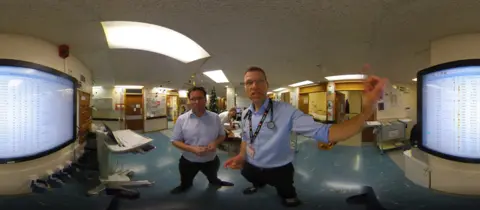Ysbyty Gwynedd pioneers electronic early warning system
 BBC
BBCIt looks like a large plasma TV in your living room, but this screen in a hospital in north Wales is already helping to save lives.
It is the face of an electronic early warning system which is alerting nurses and doctors to sudden changes in patients' conditions quicker.
The "scoreboard" in two wards at Ysbyty Gwynedd in Bangor records vital signs such as heart and respiratory rates.
A 80% drop in cardiac arrests was recorded under the new system.
There was also a 40% drop in mortality rates for those patients who ended up in intensive care.
The research involving 2,200 patients looked at the impact when the electronic system - a first in Europe - was brought in.
It has been developed from a scoring system for measuring how patients are progressing while in hospital. It was first trialled in Wrexham six years ago and then rolled out across NHS Wales.
Wales became one of the first countries in the world to issue a simple colour-coded card to staff, to improve the monitoring of patients.
Each vital sign is measured and then checked against the card, before patients are given a score.
The electronics system, developed by Philips, takes it a stage further.
It has been trialled on two wards at Bangor under the supervision of Dr Chris Subbe, consultant physician and a co-author of the study.
All patient vital signs - including pulse, consciousness and blood pressure - are still checked at least twice a day and sometimes hourly by nurses or picked up by wireless sensors.
But now the results are automatically captured and early warning scores (EWS) are displayed on a large plasma screen back at the nurses' station.
If the patient's "score" rises it prompts medical staff to intervene; the system will also page rapid response teams when a case becomes serious.
It looked at the wards of mostly elderly patients before and when the new system was in operation, and found:
- Fewer people were dying (mortality fell from 8.1% to 6.5%)
- There were 14 cardiac arrests on the ward before - and only two with the new system in the same period
- The number of serious events involving patients on the ward decreased by 35%
Dr Subbe said: "I can have 30 patients on the ward, many of them will have multiple conditions - diabetes, heart failure, asthma and other problems, they'll be on lots of different medication, so there are lots of things I need to keep an eye on.
"It's quite easy to overlook the one thing that is starting to change and tell me that the person is getting worse."
Entering measurements manually can have pitfalls, especially in a high-pressure environment. It is time consuming, relies on people doing it correctly and also decisions then need to be made on whether the patient needs more help.
But Dr Subbe said the new system is more streamlined.
"All this is now automated, from the moment the measurement is done, from the nurse putting the blood pressure cuff on or the temperature device in the ear, that measurement is generated and the machine will assist in the process of calling for help," he said.
Dr Subbe said health services can be slow to pick up on technology, which is already standard in the nuclear power and aircraft engineering industries and others where safety is crucial.
He said the early warning principle was already having an impact but is confident the electronic version "could take it to the next level".
"We were the first ones who picked up the idea and put numbers behind it, the first to roll it out at scale and we are the first now to put the technological solution on it to show what the actual impact is for patients," he added.
